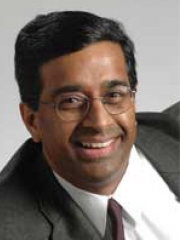R. Ramesh received his Ph.D. from UC Berkeley in 1987. APS David Adler Lectureship, 2005; Distinguished University Professor, University of Maryland, College Park, 2003; Fellow, American Physical Society, 2001; A. James Clark School of Engineering Faculty Outstanding Research Award, 2001; Alexander von Humboldt Senior Scientist Prize, 2001; International Symposium on Integrated Ferroelectrics, Award for Outstanding Achievement in Integrated Ferroelectrics, 2000; Distinguished Research Faculty Fellow, University of Maryland 1999-2000; Bellcore Corporate Award, 1994, 1993, 1992; Earl R. Parker Fellowship, American Society for Metals, 1987; Graduate Student Award, Materials Research Society , 1987; Ross M. Tucker Award, Intel Corporation and N. California Chapter of AIME, 1986-1987; James Monroe McDonald Scholarship, 1986-1987; Regent’s Fellowship, University of California, Berkeley, 1984-1985; Vidya Bharati Award in Metallurgy, Indian Institute of Metals, 1983; K.K.Mullick Gold Medal in Metallurgy, 1983; National Merit Scholarship during B.E., 1980-1983; College Gold Medal, 1980; National Merit Scholarship during B.Sc, 1977-1980. Ramesh joined the UC Berkeley Physics Department in January 2004.
Research Interests
Thin film growth and materials physics of complex oxides: Structure-Property-Processing interrelationships; Crystalline Oxides on Semiconductors; Functional metal oxide thin film deposition and processing for microelectronic, magneto-electronic, optical and high frequency applications; Oxide thin film heterostructures: growth mechanisms and defect structures; physics of magneto-transport and electro-transport; half-metallic ferromagnets; transport phenomena in highly correlated systems; Coupling between spin-orbital-lattice in complex systems; physics of finite size effects in ferroics; Multiferroic oxide heterostructures; size effects; self-assembled oxide nanostructures; coupling of order parameters.
Nanoscale Characterization: Understanding materials physics at the nanoscale using Scanned Probes; Applications of scanning force microscopy to study domains, switching and polarization dynamics in ferroic thin films; scaling studies using electric and magnetic force microscopy; phase transitions at the nanoscale; Application of TEM techniques to solving materials problems; high resolution imaging of defect and crystal structure; analytical electron microscopy and micro-diffraction techniques; Lorentz imaging of domains;
Materials Processing for Devices: Nano-fabrication technologies; novel physical phenomena in complex electronic and magnetic materials with shrinking dimensions; dry etching technologies for device fabrication.
Information Technologies: Non-volatile information storage technologies; Ferroelectric Memories; Dynamic Random Access Memories; Field effect devices; Thin film magnetic and magneto-resistive devices; CMR thin films and heterostructures; oxide spin valves and magnetic tunnel junctions.
Current Projects
Professor Ramesh is known throughout the world for his contributions to the science and technology of complex functional oxide materials. Working initially in the early 1990’s at Bellcore, he made landmark contributions in ferroelectric perovskites through the recognition that conducting oxide electrodes are the solution to the problem of polarization fatigue, which for 30 years, remained an enigmatic, unsolved problem. This is now recognized worldwide: many industrial and academic research laboratories have implemented his approach and the first series of products based on the use of conducting oxide electrodes are hitting the marketplace. In 1994, in collaboration with S. Jin (Lucent Technologies), he initiated research into manganite thin films and they coined the term, Colossal Magnetoresistive (CMR) Oxides; the paper published in Science is the 4th highest cited paper (more than 2000 citations). This work was the starting point for an intense international R&D effort on these materials, with several promising approaches for new devices. He continues to pursue key scientific and technological problems in half metallic magnetic oxides within a framework of multicomponent oxide thin films and heterostructures. His work in this field has also led to the discovery of novel field effect devices that combine the properties of ferroelectric and magnetic perovskites. His current research activities encompass probing the physics of nanoscale phenomena in complex oxide heterostructures, multifunctional oxides, approaches to create self-assembled functional nanostructures, integration of complex oxides with semiconductor technologies, and the use of nanoscale scanned probes to understand fundamental properties and dynamics in such materials. His work is cited extensively (over 13000 citations), and he ranks among the Highly Cited Physicists around the world in the Physics Citation Index. He has been issued 26 patents with 1 more under consideration. He was honored by the International Symposium on Integrated Ferroelectrics with an Outstanding Achievement Award in 2000. In 2001, he was awarded the Humboldt Senior Scientist Prize by the Alexander von Humboldt Foundation, and Fellowship in the American Physical Society. He was recently appointed Distinguished University Professor, the highest academic honor at the University of Maryland (2003). In 2005, he was awarded the American Physical Society’s David Adler Lectureship.
Publications
Over 250 papers, reviews and monographs covering magnetic materials, recording materials, magnetic and magnetoresistive metal oxides, high temperature superconductors, ferroelectrics, dielectrics, piezoelectrics and relaxors, semiconductor heterostructures and advanced transmission electron microscopy techniques applied to materials characterization. Over 14000 citations that place him in the top-250 (among approximately 270,000 worldwide).
Journals include Science, Nature, Applied Physics Letters, Journal of Applied Physics, Journal of Materials Research, Integrated Ferroelectrics, Journal of Magnetism and Magnetic Materials, Annual Reviews of Materials Science, Physical Review Letters, Physical Review B, Materials Science and Engineering B, Jl. of Electronic Materials, Journal of Electroceramics.

